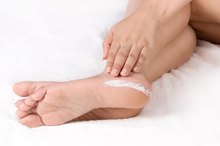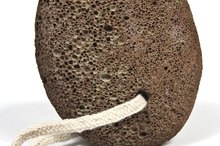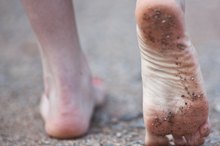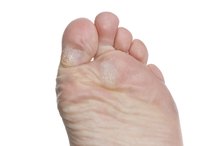What does fact checked mean?
At Healthfully, we strive to deliver objective content that is accurate and up-to-date. Our team periodically reviews articles in order to ensure content quality. The sources cited below consist of evidence from peer-reviewed journals, prominent medical organizations, academic associations, and government data.
The information contained on this site is for informational purposes only, and should not be used as a substitute for the advice of a professional health care provider. Please check with the appropriate physician regarding health questions and concerns. Although we strive to deliver accurate and up-to-date information, no guarantee to that effect is made.
Cracked Bleeding Feet
Excessive dryness of the skin on your feet or anywhere on your body is referred to as xerosis. It’s more common in winter and leaves your feet flaky, itchy and irritated. In severe cases, your skin may also develop cracks or fissures, according to the Milton S. Hershey Medical Center College of Medicine 1. Cracks may eventually bleed and can lead to additional health complications.
Causes
Your feet become very dry when you bathe in hot water, wear open shoes or spend too much time in the sun. Constantly wearing socks with or tights made with absorbent fabrics also robs your skin of its own moisture and oils. Infrequent moisturizing and medical problems such as diabetes are also factors. While cracks can develop all over your feet, especially on your heels, in most cases it’s the heels that are likely to bleed.
- Your feet become very dry when you bathe in hot water, wear open shoes or spend too much time in the sun.
- Constantly wearing socks with or tights made with absorbent fabrics also robs your skin of its own moisture and oils.
Assessment
How to Fix Cracked Heels
Learn More
When xerosis becomes so severe that your skin cracks, you should see your family doctor or a dermatologist, advises MayoClinic.com 2. Cracks on the feet prevent your skin from acting as a protective barrier, which can lead to infections, sores or ulcers. A doctor can properly assess your condition and determine the causes to recommend the best possible treatment.
Treatment
It’s best to treat dryness on your feet before it progresses to cracking and bleeding. However, if your feet are already at this stage, your doctor may recommend using wet dressings with mild astringents to close the crack, reduce oozing and prevent infection, according to the Mayo Clinic. A hydrocortisone cream or an over-the-counter cream containing lactic acid alone, or in combination with urea, can also help skin heal.
Cleansing
Salicylic Acid & Heel Cracks
Learn More
Do not spend too much time in the shower or bath; exposure to too much water dries out skin and makes xerosis worse. Use cool or lukewarm water when bathing or showering. Add a few drops baby oil to your bath water, but be careful not to slip getting in and out of the bath. Pat your feet dry—do not rub. Apply a medicated or thick moisturizer to your feet while your skin is still slightly damp. Seal in the moisture with baby oil or a natural oil such as jojoba.
- Do not spend too much time in the shower or bath; exposure to too much water dries out skin and makes xerosis worse.
- Apply a medicated or thick moisturizer to your feet while your skin is still slightly damp.
Lifestyle Changes
After applying a medicated cream or lotion, wear silky socks, heel protectors or heel socks to trap moisture. Wash or change them frequently to protect your feet from an infection. Avoid wearing open shoes or wear sunscreen when going outside. The Hershey Medical Center School of Medicine also recommends eating a balanced diet and drinking lots of water to keep your skin supple 1.
- After applying a medicated cream or lotion, wear silky socks, heel protectors or heel socks to trap moisture.
Caution
Avoid foot baths when you have xerosis, or any open wound or sore on your feet. Do not scratch your skin if it’s itchy. Apply cold compresses. Use a pumice stone to gently smooth out rough, cracked skin rather than using a sharp implement such as a scissors to remove the skin.
- Avoid foot baths when you have xerosis, or any open wound or sore on your feet.
Related Articles
References
- Milton S. Hershey Medical Center College of Medicine: Xerosis
- MayoClinic.com: Dry Skin – Preparing for Your Appointment
- Foot Care Expert: Preventing and Treating Cracked Heels
- Shim JH, Park JH, Lee JH, Lee DY, Yang JM. Moisturizers are effective in the treatment of xerosis irrespectively from their particular formulation: results from a prospective, randomized, double‐blind controlled trial. J Eur Acad Dermatol Venereol. J Eur Acad Dermatol Venereol. 2016 Feb;30(2):276-81. doi: 10.1111/jdv.13472.
- Celleno L. Topical urea in skincare: A review. Dermatol Ther. 2018 Nov;31(6):e12690. doi:10.1111/dth.12690.
- Fowler J. Understanding the Role of Natural Moisturizing Factor in Skin Hydration. Practical Dermatology. July 2012;36-40.
- Reszke R, Pełka D, Walasek A, Machaj Z, Reich A. Skin disorders in elderly subjects. Int J Dermatol. 2015 Sep;54(9):e332-8. doi:10.1111/ijd.12832.
- White-Chu EF, Reddy M. Dry skin in the elderly: complexities of a common problem. Clin Dermatol. 2011 Jan-Feb;29(1):37-42. doi:10.1016/j.clindermatol.2010.07.005.
Writer Bio
Kay Uzoma has been writing professionally since 1999. Her work has appeared in "Reader’s Digest," "Balance," pharmaceutical and natural health newsletters and on websites such as QualityHealth.com. She is a former editor for a national Canadian magazine and holds a Bachelor of Arts in political science from York University.









